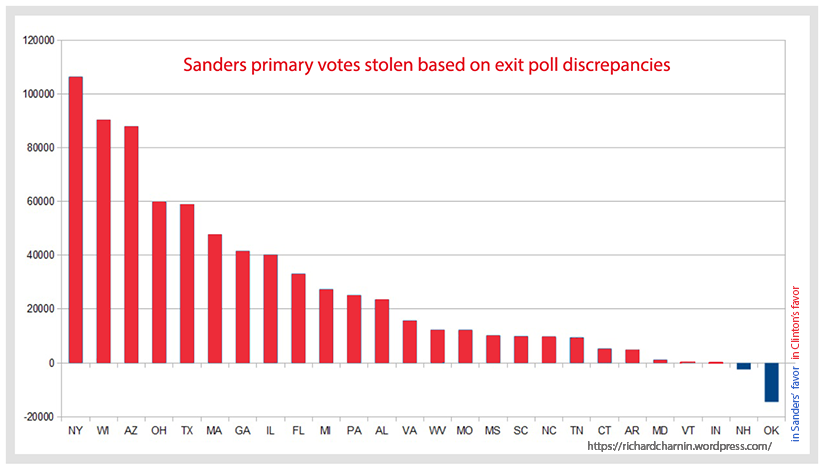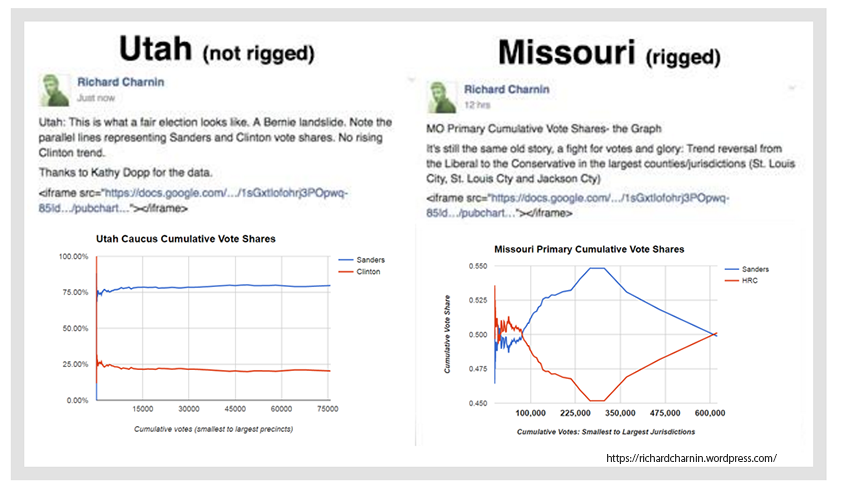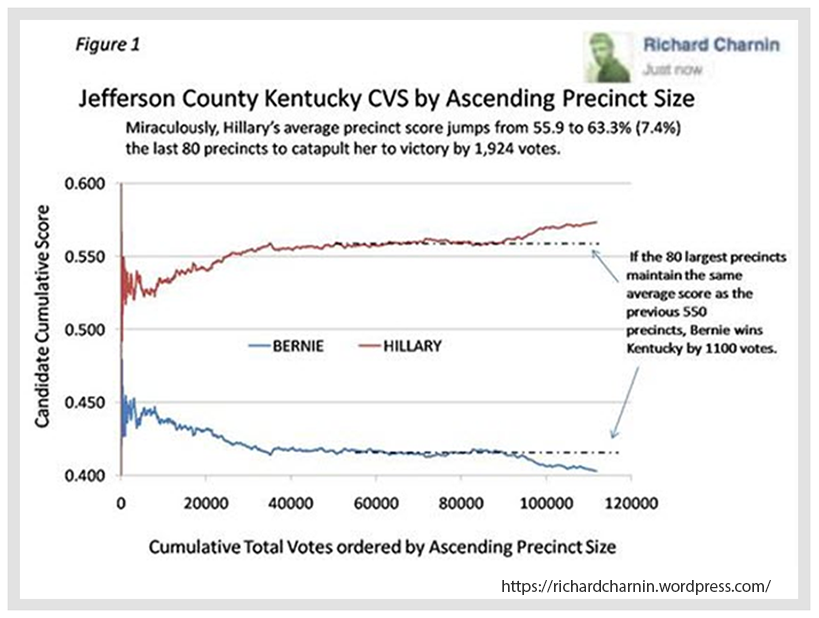My brother Marcello and I have been talking about electoral irregularities for months. He’s an astronomer by training, a software engineer, and an avid follower of American politics. I’m a microelectronic engineer and a finance person living in the United States for the past 20 years. As Italians we both look at American politics with a great deal of curiosity and sometimes disbelief. As a naturalized American, I worry.
Recently, Marcello became interested in the sort of calculation that could actually detect electoral fraud having heard about so many indications of electoral rigging in these past democratic primaries. After delving into the investigations of mathematician and numerical control engineer Richard Charnin, FBI journalist investigator Greg Palast[1], and election investigator and analyst Bev Harris[2], among others, he is persuaded not only that statistical methods can show when fraud has taken place, but that in fact the American electoral system is structured to allow it and to hide it[3]. He spent a few days unpacking a few statistical concepts for me regarding this proposition and I will try to convey them to you.
First we should be aware that exit polls, the polls of voters taken immediately after they have exited the polling stations, are the only way to check against fraud in elections while keeping the vote confidential. A discrepancy between the declared vote (recorded vote) and the vote extrapolated from the exit polls is an indication of fraud when it is above a margin of error of 2% within a confidence level of 95%.
Here is how it works. When statisticians try to measure the ‘real vote’ they not only estimate the final vote count but they also analyze the entire distribution of the data they gathered from the exit poll voter sampling in order to determine the reliability of their final determination. When fluctuations in the data are due to randomness they will follow a statistical distribution that follows the shape of a bell curve, the Gaussian curve. The reliability or unreliability of the sample data doesn’t depend so much on the trustworthiness of those who collect the exit poll voter sampling, but it’s rather intrinsic to the shape of the distribution. From this shape an ‘interval of confidence’ is determined within which we can unquestionably claim our confidence that we got it right with a probability of 95% — always 95%. This interval of confidence is also called ‘margin of error’ (MoE).
Poorly informed ‘experts’ frequently argue that the statistical analysis of exit polls can be misleading because it assumes that real life data is randomly distributed (as in the Gaussian curve) when that’s not always the case. And here is where they are missing a central point. The expectation that sample data will be randomly distributed ALREADY takes into account all possible relevant factors in a practical observation in real life. When extraneous factors intervene, a discrepancy will make the recorded value fall outside of the interval of confidence signaling only one possibility: a systematic error. When this occurs statisticians make further analysis to determine the causes, and either remove the cause or include it into the ‘margin of error’. After 59 years of fine-tuning this process in countless elections around the world statisticians have reached a point where exit polls have become extremely reliable. If the final ‘Recorded Vote’ falls outside the interval of confidence one can assume with a high degree of certainty that the systematic error is intentional. This is why we say that we have a high probability of fraud.
The fact that such a high probability of fraud is so apparent in the comparison of exit polls and recorded vote is partially masked by the way electoral results are obtained in the United States. The results of most democratic elections around the world are obtained with a 95% confidence level within a margin of error of 2%. In fact, these are the parameters that the U.S. government normally uses to oversee elections in other countries (https://en.wikipedia.org/wiki/List_of_controversial_elections). But this is not true in the U.S itself — which nobody thinks of supervising.
Election results in the United States are obtained with a 95% confidence level within a 3-4% margin of error. This is because relatively recent laws in the United States have intentionally rendered reference data less reliable (HAVA, Bush 2002). By law exit polls must be adjusted to match the final recorded vote, which means that evidence of fraud is suppressed. Exit poll results, already partially manipulated, must disappear after a given election and become public only 5 years later. When such data has become available in its unadjusted complete form, it has been used to cross-check voting results with other independent methods. The results have not only shown that the numbers were internally coherent but also that they corroborated original suspicions of fraud.
In the 2016 democratic primary elections unadjusted exit polls show that Bernie Sanders has been robbed of the following percentage of votes: Alabama 6.1%, Arizona 22.1%, Georgia 5.5%, Massachusetts 4.0%, Mississippi 4.7%, Ohio 5.0%, South Carolina 5.2%, Texas 4.2%, Wisconsin 6.9%, West Virginia 6.0%, New York 5.9% (CNN New York exit polls indicated that Bernie Sanders may have done better than 48% there).
Although a discrepancy of -4.6% in Oklahoma turned out to be in favor of Bernie, it doesn't affect our analysis[4] because so far the discrepancies shown in all of the above final results have been consistently larger than the MoE in favor of Hillary in 11 of the 26 primaries. The probability of this happening without fraud is 1 in 77 billion (6.8-sigma). In other words, one can expect something this improbable to happen less than once since the extinction of dinosaurs — if elections were to be a daily event.

The probability P of this happening is 1 in 77 billion.
One can also search for trends to check for fraud. One of the most revealing methods, the Cumulative Vote Share Analysis, searches for a correlation between the size of a discrepancy (between recorded vote and exit polls) and the size of a precinct. When no fraud has taken place the trend tends to be quite regular. When the discrepancy tends to manifest as the size of the precinct becomes larger than a certain value, it is a strong indication of fraud, according to Richard Charnin. Roughly speaking the reason for this behavior is that electronic rigging is implemented strategically in order not to become obvious. The discrepancy caused by the rigging is “better” distributed between those precincts that are big enough to be worth the effort.

There should be no correlation, like we see on the diagram on the left (Utah).
In fact, in the recent democratic primaries we can observe a noticeable divergence in trends between the Clinton and Sanders votes when the precincts are larger; the larger the size, the higher the percentage of the votes that go in favor of Clinton. This has been evident in Massachusetts (>10%), Michigan (>3%-10% according to the type of machines), Missouri (>0.05% the size is small but the trend unequivocal), New York (>10% and possibly >20%). Charnin’s diagrams (see below) are self-explanatory.

All in all electoral anomalies have been apparent in New York, Massachusetts, Illinois, Arizona, Iowa, Nevada, Ohio, Delaware, Wyoming, Wisconsin, Missouri, Michigan, Alabama, Tennessee, Georgia, Arkansas, Texas, Kentucky and Oregon. But electoral fraud has been particularly evident in strategic elections such as those in Arizona and New York. They were meant to kill the Bernie Sander's momentum. And they did just that with the help of the media.
Disenfranchisement — widespread in New York and Arizona — has been more widely reported so I will not discuss it here. But in any case it must be added to other forms of electoral fraud.
According to the recorded vote the Sanders-Clinton competition is currently at 43.5-56.5% with a lead of 3 million votes in favor of Clinton. But actual votes in caucus states have not been included, and the fact that unadjusted exit polls have indicated that voting machines were hacked has not been considered. According to Charnin, if we take this into account we would have Sanders at 47.9 and Clinton at 52.1%, with a lead of 1.3 million votes in favor of Clinton. Furthermore, if we also take into consideration that voter rolls were manipulated and that long lines and severely shortened polling station hours reduced voter turnout in areas favorable to Sanders, we would need to add a 10% to Sanders’s votes and subtract 5% from Clinton’s. That would put Sanders in the lead at 51.5-48.5% with a lead of 780,000 votes in his favor.[5]
Sanders's supporters have barely begun to speak about electoral irregularities and already the DNC has started to accuse them and Sander's campaign of inciting "violence" among supporters by promoting allegations that the primary process is rigged in favor of his opponent, Hillary Clinton.[6]
There's much more to say. This is only a piece of the larger story of how fraud has become part and parcel of American elections, which has been at work since the 1960s, reaching extraordinary highs after the year 2000. Most notable have been the elections stolen from Al Gore by 6 million votes, from Kerry by more than 10 million and the landslide vote margins stolen from Obama both in 2008 and 2012. But if until now the biggest share of electoral rigging has come from the Republicans by far, it looks like the Democrats are more than willing to step up to the plate if an uncorrupt candidate dares to challenge their establishment.
Berkeley, June 3rd, 2016